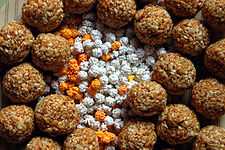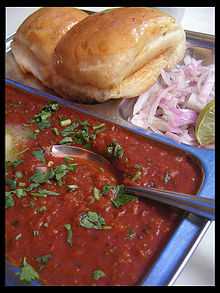Maharashtrian cuisine
 |
| This article is part of the series |
| Indian cuisine |
|---|
|
Regional cuisines
|
|
Ingredients / types of food
|
|
See also
|
|
Related cuisines |
|
Maharashtrian (or Marathi) cuisine is cuisine of the Marathi people from the state of Maharashtra in India. Maharashtrian cuisine covers a range from being mild to very spicy dishes. Wheat, rice, jowar, bajri, vegetables, lentils and fruit form staples of Maharashtrian diet. Traditionally, Maharashtrians have considered their food to be more austere than that of other regions in India. Also, because of economic conditions and culture, meat has traditionally been used quite sparsely or only by the well off until recently. Maharashtra's metropolitan cities like Mumbai and Pune has influenced the food habits due to urban population. For example, the Udupi dishes like idli and Dosa are quite popular and also Chinese dishes. Nevertheless, distinctly Maharashtrian dishes such as ukdiche Modak and aluchi bhaji remain popular.
Regular meals and staple dishes
The staple dishes of Maharashtrian cuisine are based on flat bread and rice. The flat breads can be wheat based such as the traditional trigonal Ghadichi Poli[1] or the round chapati more common in urban areas. Bhakri - bread made from millets like jowar and bajra, form part of daily food in rural areas.[2] As many areas of Maharashtra are drought prone, traditionally the staple food of the rural poor has been as simple as Bajri Bhakri accompanied by just a raw onion, a dry chutney or a Gram flour preparation called Zunka or Pithale. This meal has, however, become now fashionable among the urban classes too.
The bhaajis are vegetable dishes made with a particular vegetable or a combination of vegetables and requires the use of Goda masala, essentially consisting of some combination of onion, garlic, ginger, red chilli powder, green chillies and mustard. Depending on the caste or specific religious tradition of a family, onion and garlic excluded in cooking. For example, a number of Hindu communities in Maharashtra and other parts of India refrain from eating onion and garlic during Chaturmas (broadly equates to the rainy monsoon season). Until recently, canned or frozen food was not widely available in Maharashtra and India. Therefore, vegetables used in a meal depended on the seasonal availability. For example, Spring ( March - May) brings harvest of cabbage, onions, potatoes, Guar Tondali, Shevgyachya shenga, Dudhi, Marrow, and Padwal. The Rainy Monsoon Season brings green leafy vegetables like Aloo. Gourds like Karle, Dodka and Egg plant also become widely available in this season. Carrots, tomatoes, Cauliflower, French beans, peas etc. become available in the cooler climate of October to February.[3]
Meat preparations
- Mutton Kolhapuri Taambda rassa (red curry)
- Mutton Kolhapuri Pandhra rassa (white curry)
Soups
In Indian cuisine soups are consumed along with the main course. Some popular soups are:
- Kadhi- Served with Khichadi, boiled rice or as part of the Thali.
- Solkadhi - prepared from coconut milk and Kokam.
- Tomato saar - Maharashtrian spicy tomato soup
- Kokam saar - Soup prepared from dried fruit of Kokam (Garcinia indica)
Pickles and condiments
- Papad
- Thecha
Sweets/desserts

- Puran Poli: It is one of the most popular sweet item in the Maharashtrian cuisine. It is made from jaggery (molasses or gur), yellow gram (chana) dal, pain flour, cardamom powder and ghee (clarified butter). It is made at almost all festivals. A meal containing puran poli is considered "heavy" by Marathi people.[4]
- Modak: is a Maharashtrian sweet typically steamed (ukdiche modak).,[5] [4] Modak is prepared during the Ganesha festival around August, when it is often given as an offering to lord Ganesha, the elephant-headed God, as it is reportedly his favorite sweet. For more info, visit . Modak can also be fried with various sweet stuffings.
- Gulab Jaam: are balls made of dense milk (Mava/Khava) and bleached wheat flour fried in ghee (clarified butter) and then dipped in sugar syrup.
- Anarsa : It is made from soaked powdered rice, jaggery or sugar. The traditional process for creating the Anarsa batter could be tedious to modern day homemakers since it takes three days.[4]
- Chirota: Made by combination of rawa (Semolina and maida Plain flour
- Jilbi: Sweetened chick-pea flour deep fried in spiral shapes, then coated in sugar syrup.
- Basundi: Sweetened dense milk dessert.
- Amras: Pulp/Thick Juice made of mangoes, with a bit of sugar if needed and milk at times.
- Shrikhand: Sweetened yogurt flavoured with saffron, cardamom and charoli nuts.
- Ladu: It is famous sweet snack in Maharashtra mainly prepared for Diwali
Appetizers or snacks






There are lots of snack and side dishes in Maharashtrian cuisine. Some quintessentially Maharashtrian dishes are:
- Chivda: spiced flattened rice. It is also known as Bombay mix in Foreign countries especially Great Britain.
- Pohay: pohay or pohe is a snack made from flattened rice. It is most likely served with tea and is probably the most likely dish that a Maharashtrian will offer his guest. During arranged marriages in Maharashtra, Kanda Pohe (literal translation, pohe prepared with onion) is most likely the dish served when the two families meet. Its so common that sometimes arranged marriage itself is referred colloquially as "kanda-pohay". Other variants on the recipe are batata pohe (where diced potatoes are used instead of onion shreds). Other famous recipes made with Pohe (flattened rice) are dadpe pohe, a mixture of raw Pohe with shredded fresh coconut, green chillies, ginger and lemon juice; and kachche pohe, raw pohe with minimal embellishments of oil, red chili powder, salt and unsauteed onion shreds.
- Upma or sanja or upeeth: This snack is similar to the south Indian upma. It is a thick porridge made of semolina perked up with green chillies, onions and other spices.
- Surali Wadi: Chick pea flour rolls with a garnishing of coconut, coriander leaves and mustard.
- Vada pav: Popular Maharashtrian "Fast food " dish consisting of fried mashed-potato dumpling (vada), eaten sandwiched in a Wheat bun (pav). This is referred to as Indian version of burger and is almost always accompanied with the famous red chutney made from garlic and chillies, and fried green chilles. Vada pav in its entirety is rarely made at home, mainly, because oven cooking at home is not common.
- Misal Pav:Quintessentially from Kolhapur. This is made from a mix of curried sprouted lentils, topped with batata-bhaji, pohay, Chivda, farsaan, raw chopped onions and tomato. Also some times eaten with yogurt. Usually, the misal is served with a Wheat bread bun.
- Pav bhaji: This speciality dish from lanes of Mumbai has mashed steamed mixed vegetables (mainly potatoes, peas, tomatoes, onions and green pepper) cooked in spices and table butter. The vegetable mix is served with soft Wheat bun shallow fried in butter and chopped onion. Sometimes cheese, paneer (cottage cheese) are added.
- Thalipeeth: A type of pancake. Usually spicy and is eaten with curd.[6]
- Sabudana Khichadi: Sauted sabudana (Pearls of sago palm), a dish commonly eaten on days of religious fasting.
- Khichdi: Made up of rice and dal with mustard seeds and onions to add flavor.
- Chana daliche dheerde
Maharashtrian cuisine like most of the Indian cuisines is laced with lots of fritters. Some of them are
- Colocasia leaves rolled in chick pea flour, steamed and then stir fried.
- Mung dal wade
- Sabudana wada
- Methi wade made with leaves of Fenugreek plant
Special occasions and festival delicacies
Champa Sashthi
Many Maharashtrian communities from all social levels observe the Khandoba Festival or Champa Shashthi in the month of Mārgashirsh. This is a six-day festival, from the first to sixth lunar day of the bright fortnight. Households perform Ghatasthapana of Khandoba during this festival. The sixth day of the festival is called Champa Sashthi. For many people, the Chaturmas period ends on Champa Sashthi. As it is customary in many families not to consume onions, garlic and egg plant (Brinjal / Aubergine) during the Chaturmas, the consumption of these food items resumes with ritual preparation of Vangyache Bharit (Baingan Bharta) and rodga, small round flat breads prepared from jwari (white millet). [7][8]
Mahashivratri
Marathi Hindu people hold a fast on this day. The fasting food on this day includes chutney prepared with pulp of the kavath fruit (Limonia).[9]
Fasting cuisine
A large number of Marathi Hindu people hold fast on days like Ekadashi in honour of Lord Vishnu or his Avatars, Chaturthi in honour of Ganesh, Mondays in honour of Shiva, or Saturday in honour of Maruti or Saturn.[10] Only a certain kinds of foods are allowed to be eaten. These include milk and milk products, fruit, sago (sabudana), potatoes, nuts such as peanuts, purple-red sweet potatoes (called ratali in Marathi), Rajgira (Amaranth seeds) and varyache tandul (Shama millet. [11]Thus a calorie and carbohydrate- rich fasting menu can be prepared by selecting from the items listed above. Popular fasting dishes include Sabudana khichadi or peanut soup (danyachi amti).[12]
References
Citations
- ↑ KHANNA, VIKAS (Dec 1, 2012). My Great Indian Cookbook. Penguin UK,.
- ↑ Khatau, Asha (2004). Epicure S Vegetarian Cuisines Of India. Mumbai: Popular Prakashan ltd. p. 57. ISBN 81-7991-119-5.
- ↑ Barve, Mangala; Translator: Datar, Snehalata. Annapurna (1 ed.). Mumbai, India: Majestic Prakashan. ISBN 9788174320032. Retrieved 24 December 2014.
- ↑ 4.0 4.1 4.2 Reejhsinghani 1975, p. x.
- ↑ Khanna, Vikas (2013). SAVOUR MUMBAI: A CULINARY JOURNEY THROUGH INDIA’S MELTING POT. New Delhi: Westland Limited.
- ↑ Khatau, Asha (2004). Epicure S Vegetarian Cuisines Of India. Mumbai: Popular Prakashan ltd. p. 63. ISBN 81-7991-119-5.
- ↑ Gupte 1994, p. 16.
- ↑ Pillai 1997, p. 192.
- ↑ Deshmukh, B. S.; Waghmode, Ahilya (July 2011). "Role of wild edible fruits as a food resource: Traditional knowledge" (PDF). I NTERNATIONAL J OURNAL OF P HARMACY & L IFE S CIENCES 2 (7): 919–924.
- ↑ Dalal 2010, p. 6.
- ↑ Dalal 2010, p. 7.
- ↑ Dalal 2010, p. 63.
Bibliography
- Reejhsinghani, Aroona (1975). Delights from Maharashtra. Mumbai: Jaico Publishing. ISBN 81-7224-518-1.
- Dalal, Tarla (2010). Faraal Foods for fasting days. Mumbai: Sanjay and Co. ISBN 9789380392028.
- Gupte, BA (1916). Hindu Holidays and Ceremonials: With Dissertations on Origin, Folklore and symbols. Calcutta: AES (reprinted 1994). p. 19. ISBN 81-206-0953-0.
- "Champa+Shashthi"&ots=oIp5CEqagQ&sig=AolgoTt4_VDsQw-3PgOUzHN8Tc8#v=onepage&q=%22Champa%20
External links
| Wikimedia Commons has media related to Cuisine of Maharashtra. |
| ||||||||||||||||||||||||||||||||||||||||||||||||||||||||
